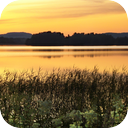(short preview of full seamless looping track)
(short preview of full seamless looping track)
(short preview of full seamless looping track)
(short preview of full seamless looping track)
(short preview of full seamless looping track)
Summer Lake
This product is not available in the selected currency.
In Stock
Backordered
Out of Stock
Description
Tiny waves wash upon shore, sliding over your toes, turning some small creature's calm summer day into a stormy freshwater sea. You are tickled by the thought that all the effort to make millions of dollars ends with you finding ultimate pleasure in something so simple and natural as the sound of a bird. If you had only known that there was more to life than being a leader and lasting longer than your competition, then perhaps you might have settled for a little house by the lake a long time ago. Limnology is the study of inland bodies of water and related ecosystems. Limnology divides lakes into three zones: the littoral zone, a sloped area close to land; the photic or open-water zone, where sunlight is abundant; and the deep-water profundal or benthic zone, where little sunlight can reach. The depth to which light can reach in lakes depends on turbidity, determined by the density and size of suspended particles. A particle is in suspension if its weight is less than the random turbidity forces acting upon it. These particles can be sedimentary or biological in origin and are responsible for the color of the water. Decaying plant matter, for instance, may be responsible for a yellow or brown color, while algae may cause greenish water. In very shallow water bodies, iron oxides make water reddish brown. At present the surface of the planet Mars is too cold and has too little atmospheric pressure to permit the pooling of liquid water on the surface. Geologic evidence appears to confirm, however, that ancient lakes once formed on the surface. It is also possible that volcanic activity on Mars will occasionally melt subsurface ice, creating large lakes.
Opps
Sorry, it looks like some products are not available in selected quantity.



